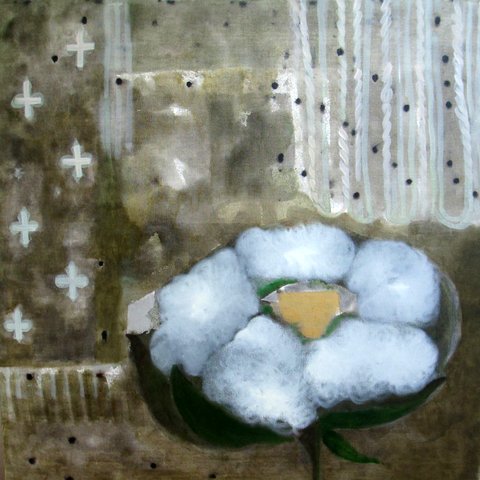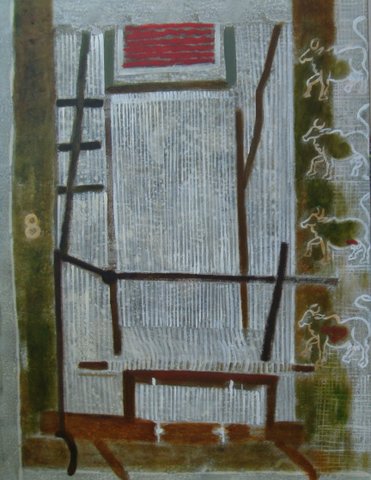Excerpts from a monograph on Rekha Rao Hebbar
Rekha engages with the contemporary world, but her painterly concerns are equally the problems of the newly independent India in which she grew up. Concerns which we have still not been able to address adequately and, which seem to have grown more monstrous and unwieldy with the passage of time. Colour- vibrant, impassioned and uninhibited – is the tool that carries her thought. Rekha approaches painting as a ‘spontaneous act’. The germ of an idea takes root, and expresses itself on canvas, often in a way that “… the subject is a catalyst for imagery, but how the image is brought forth is usually a surprise, even for the artist.”
Events, intellectual and political thought, chance encounters, observations, dance, cinema, and music, human interactions all form the memories of the artist, which are expressed on canvas. That moment, ordinary, evanescent, but with its own, unique energy, is recreated and transformed by the artist. For Rekha, this experience, of an almost Proustian ‘remembrance of things past’ is an intuitive process. For her, there are no preliminary sketches or studies.She approaches her material directly, with the confidence of flat, broad, brush strokes, and a superb handling of colour. Stripes, dashes, flat, combed strokes and pointillist dots measure out her canvases in glorious outpourings of colour.

Her works are often half- told tales, allusive, sometimes enigmatic. Of this she says, “There is no need to look too eagerly for signs of the recognizable, but rather recognize an emotion as one senses the coming of a breeze….” Often joyful, the surface playfulness belies a sharp intellect, and considered reflections on social causes and movements, and the forces of history. Rekha’s interpretations speak in a language of smudges and accents, and every canvas asserts the primacy of colour. Colour is a powerful signifier. In fact, it is her audacious and uninhibited use of colour that lends her works a particular depth and luminosity, and elevates them into the world of metaphor.
“Let colours speak to you as inexplicably as music,” K.K.Hebbar impressed on her. And Rekha did. Slowly, systematically, she built up a vocabulary of colour, which has the strength to carry the weight of her mature vision and work.
Hebbar’s mezzanine studio was a microcosm of the larger art world in Bombay, and as Rekha recalls, “it crackled with creative energy. Not a day passed without visitors – artists, writers, dancers, musicians and students dropping by.” The ebullience and idealism of a young nation, and a Bombay awash with energy and talent,filtered into the Hebbar home. “Looming over this crowd,” writes Yashodara Dalmia, “was the writer and art patron Mulk Raj Anand,”4 he had founded the Progressive Writer’s Association in 1934, in London. He was now publishing MARG, a journal dedicated to the arts, and was a close friend of Hebbar’s, and a frequent visitor to his home– his collection of short stories was illustrated by the artist.

Debates raged endlessly about art, tradition and social issues. A particularly charged topic was the challenge of incorporating Indian elements into art, and the search for a synthesis to carry their art into modernism. The young Rekha blotted it all up. Every Diwali saw Karl and Mary Khandalavala, Harkishenlal, Mulk Raj Anand and Shirin, and sometimes Ara, converging on the Hebbar home. In that festive, typically Indian atmosphere, with exotic paper lanterns and rangolis created by Hebbar himself, an exchange of ideas artistic flourished.
At the heart of her artistic world was her relationship with her father. Hebbar taught her how to apply paint on the canvas, but refused to do more than nudge her into finding her own vision. Yet Rekha recalls how every painting she saw, every exhibition she attended, every canvas she painted was discussed threadbare with Hebbar.
With such an intense relationship, how did Rekha manage to untangle the skeins of her independent development as a gifted artist, from that of the loving daughter of one of India’s most eminent artist’s, who also happened to be her artistic mentor?
The failed promises of independent India echo in a number of paintings. In Migrants, painted in 2002,against the background of somber, rust splattered ochres, and an apocalyptic sky full of smoke and fumes of factories on the near side of a wavering fence, placed there by whom, we are not sure, is what at first appears to be a pathetic bundle of belongings. As you blink, it seems to be a huddle of ragged figures. Rekha has mastered the use of scattering shards of allegory in her works. Urban decay and the erosion of life are conveyed through a series of refracted images.

In 2003 she painted a series of cityscapes on paper, based on the map of that great, unwieldy metropolis, Mumbai. Her travels by suburban train, and Mumbai busses become a modern landscape history. “Charni Road Station, Borivili West, Haji Ali – all the titles are a shorthand for the millions of lives that crisscross this vast cityscape every single day, in the pursuit of their dreams. Mumbai is abbreviated into the grid of the suburban railway system.
Pointillist dots and dabs are smudged over, layers of colours and texture emerge from the canvas, subtle shades float to the surface, while electric blue dashes cascade slowly downwards, suggesting Ghandi’s handspun, hand-woven, breathing fabric, symbolic of the resistance and victory of an entire nation.
The carding and combing of cotton descends on the viewer in a considered harmony and balance of greys, whites, swirls of floss and fibre; the great explosions of the birth of cotton are suggested in the fluffy flower in the foreground of Cotton Flower.
Image Courtesy: Rekha Rao




